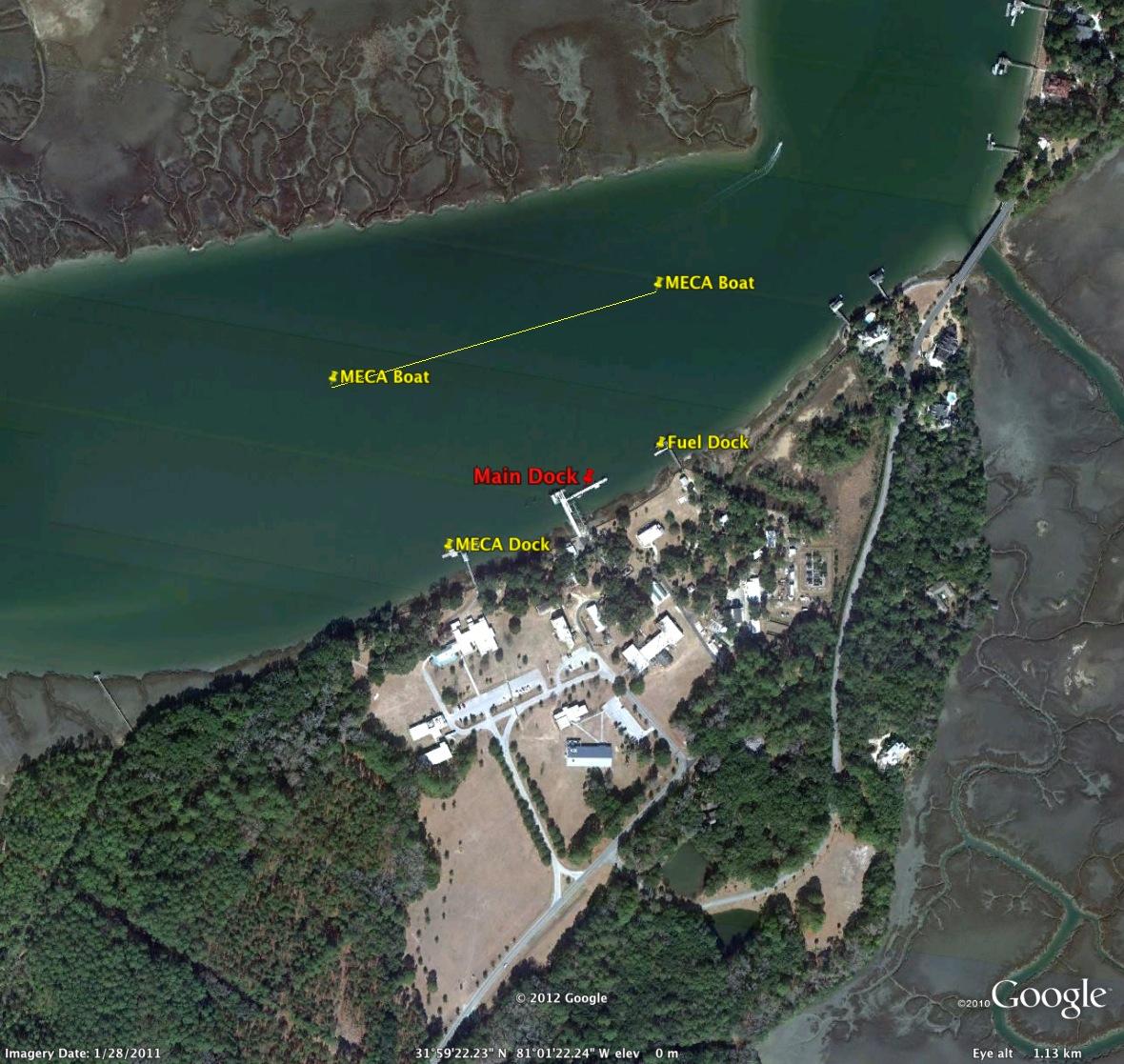Project: Skidaway River Monitoring Program
Description
In estuaries of the South Atlantic Bight, one of the longest and most extensive datasets of plankton and bacteria biomass and composition is from the Skidaway River and the associated Wassaw Sound estuarine system in Georgia. Wassaw Sound is a tidally dominated, bar-built estuary surrounded by extensive stands of salt marsh. Although pristine compared to industrially impacted waterways such as the Savannah River and Charleston Harbor, residential development and population density around the Wassaw Sound system have been increasing rapidly.
Since 1986 the Skidaway River Monitoring Program (SRiMP) has maintained a time series observation dataset of hydrography, nutrients, phytoplankton, heterotrophic microbial communities, mesozooplankton, representative gelatinous nekton, and dissolved oxygen. Samples have been collected approximately weekly from the main dock at the Skidaway Institute of Oceanography. The start of the program was coincident with the rapid development of Skidaway Island, Georiga USA that has transformed a marsh and maritime forest covered ancient barrier island to an island dominated by a residential luxury golf course community. Population growth in the 1980's was as high as 25% annually, but has since declined to <3% annually as island development has neared completion. Evidence from the SRiMP study support the hypothesis of causative linkages between human population growth, nutrient loading, and ecosystem alteration.
The long-term goal of this project is to understand how warm, well-mixed, subtropical estuaries vary their plankton community structure, function, and net ecosystem metabolism in response to increasing anthropogenic nutrient loading and natural environmental forcing. The approach is to continue a unique, long-term (19 years), temporally intensive (sampling twice per week) record in the Skidaway River estuary (Georgia, USA) of hydrography, nutrients, plankton and microbial communities, dissolved oxygen, and important living and non-living components of particulate matter. The record to date documents changes caused by cultural eutrophication throughout the food web from bacteria to copepods; independently collected evidence shows major declines in commercial catches of fin- and shellfish. Commonly accepted conceptual models and limited local evidence support the notion that gelatinous predators may benefit from the enhanced microbial food web and from decreased competition from vertebrates and invertebrates. These data will be used to evaluate estuarine biological and chemical responses to, and potential recovery from, the by-products of increasing human occupation of the coast, as well as chronic (long-term warming, rising sea level, extended drought or wet periods) and stochastic (tropical storms) patterns in natural phenomena. Questions to be addressed fall into two basic categories: (a) how do plankton communities (individual taxa and bulk properties) respond in structure and function to early stages of eutrophication that include changes in concentrations and ratios of all major inorganic and organic nutrients, and (b) are such changes consonant with accepted ecological theory for estuarine ecosystems?
The working hypothesis is that changes in nutrient loading have altered the competitive balance among phytoplankton, bacteria, and associated microbial communities, thus impacting higher trophic levels. A major corollary is that changes in food web structure at the lower levels are driving a long-term shift from oxic towards hypoxic conditions, i.e. from autotrophy to net heterotrophy. These lower oxygen concentrations may facilitate the development of gelatinous predators communities to fill the void caused by declines in fin- and shellfish. This study aims to provide sound scientific data on historic and contemporary patterns in plankton community structure, ecosystem function, and relationships to environmental variables, including trends in dissolved oxygen, as well as the quantitative basis to evaluate basic ecological hypotheses regarding estuarine ecosystems.
Skidaway Institute for Oceanography - Sampling Locations - Main Dock, Fuel Dock, MECA Dock and the MECA Boat.
Most of the sampling is, and has been done, at the Main Dock: 31°59'23.96"N, 81°01' 21.09"W
Some sampling has been performed at the:
Fuel Dock: 31°59'25.19"N, 81°01' 17.40"W
MECA Dock: 31°59'21.48"N, 81°01' 26.62"
MECA Boat: 31°59'27.66"N, 81°01' 31.93"W to 31°59'30.68"N, 81°01'13.05"
Funded as NSF-OCE Award #0545312: Patterns of Ecosystem Function and Trophic Status in Well-mixed Subtropical Estuaries Undergoing Anthropogenic Modification
| Dataset | Latest Version Date | Current State |
|---|---|---|
| Time series observations: hydrography, nutrients, and microbial, phytoplankton and zooplankton communities from the Skidaway River Estuary on the southeastern Atlantic coast of Georgia from 1986-2011 (SRiMP project) | 2012-10-31 | Preliminary and in progress |
| Sample locations from the Skidaway River Estuary on the southeastern Atlantic coast of Georgia from 1986-2011 (SRiMP project) | 2012-05-14 | Final no updates expected |

People
Lead Principal Investigator: Marc E. Frischer
Skidaway Institute of Oceanography (SkIO)
Project Coordinator: Dr Stella Berger
Skidaway Institute of Oceanography (SkIO)
Contact: Dr Stella Berger
Skidaway Institute of Oceanography (SkIO)
Contact: Marc E. Frischer
Skidaway Institute of Oceanography (SkIO)
